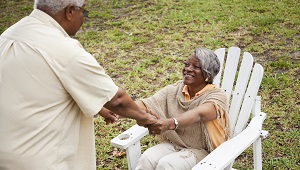Changing sitting habits shows meaningful impact
Video produced by Melissa Parson
A new trial highlights a promising intervention to improve blood pressure in older adults
Evidence is clear that sedentary behavior — sitting or lying down for long periods of time throughout the day — increases the risk of chronic conditions like type 2 diabetes and cardiovascular disease. But changing those patterns can be challenging. A new study led by researchers at Kaiser Permanente Washington Health Research Institute (KPWHRI) used a relatively simple approach to successfully reduce sitting time for a group of older adults by around 30 minutes a day. The reduction in sedentary time led to improvements in blood pressure comparable to those found in studies where participants increased their time spent exercising.
In the study, researchers used a computer model to randomly split participants into 2 groups. One group received a simple tabletop standing desk, an activity tracker, and 10 health coaching sessions over 6 months, in which they set goals for reducing their time spent sitting. The other group (the control group) also participated in health coaching, but their goals were focused on areas of health that were not related to standing or increasing activity. The study was published in JAMA Network Open.
"Our findings are really promising because sitting less is a change that may be easier for people than increasing physical activity, especially for older adults who are more likely to be living with restrictions like chronic pain or reduced physical ability," said Dori Rosenberg, PhD, MPH, the lead author of the study and a senior investigator at KPWHRI.
All the participants were Kaiser Permanente Washington members age 60 to 89 who reported sitting for more than 6 hours a day. More than half had a diagnosis of high blood pressure, over a quarter had a diabetes diagnosis, and almost two-thirds took at least one medication for lowering blood pressure.
“In our study, participants sat for an average of more than 10.5 hours per day, or 70% of daily waking hours. This can put people at risk for health challenges like worsened physical ability and falls," Rosenberg said. "There are also high rates of hypertension in adults over age 60. Our preliminary research suggested that this intervention, focused on standing more during the day, could have a positive effect on blood pressure and potentially reduce other health risks."
Setting goals, finding strategies
The study intervention, called I-STAND, was based on health coaching to provide encouragement and individualized goal-setting. Since most people sit automatically without thinking about it throughout the day, participants figured out ways to frequently remind themselves to take breaks from sitting or stand more. For example, people used the fitness tracker’s hourly alert to move. Other participants added standing to habits they already do — such as standing to read the front page of the newspaper or for the first cup of coffee in the morning.
Participants wore an accelerometer that measured standing and sitting time, and a fitness tracker that could be set to go off at 15-minute to 60-minute intervals to remind them to take breaks from sitting. At the end of the study, the intervention group sat for 32 minutes less per day, on average, compared with the control group. Their average blood pressure was also almost 3.5 mmHg lower, comparable to reductions of 4 mmHg in studies of increased physical activity and 3 mmHg in studies of weight loss.
"When we sit, we aren't using major muscle groups, and our blood flow is reduced," Rosenberg said. "Changing those mechanisms could be one reason for the significant improvement in blood pressure that we saw in this trial."
Due to the restrictions of the COVID-19 pandemic, most of the health coaching sessions were delivered remotely. Even though many participants only had virtual sessions, they were still able to change their sitting patterns.
Next steps
The researchers are looking at several possible follow-up studies that could take these findings further. In particular, they are interested in understanding whether a slimmed-down version of the intervention might work just as well.
"We aren't sure which piece of this was most impactful," Rosenberg said. "Do people need the desk and the activity tracker and 10 coaching sessions to successfully change their sitting time? Or might they be able to do it with one or two pieces of that? Having a little more insight will be useful when we look at how to best implement this in a health care setting where resources might be limited."
The researchers are also interested in looking at whether the intervention has an impact on fall risk or brain health in older adults.
KPWHRI coauthors on the study are Weiwei Zhu, MS; Mikael Anne Greenwood-Hickman, MPH; Andrea Cook, PhD; Jennifer McClure, PhD; David Arterburn, MD, MPH; Julie Cooper, MPA; Stephen Perry, BA; Laura Yarborough, RN; Kayne Mettert, BA; and Beverly Green, MD, MPH. The study was funded by the National Heart, Lung, and Blood Institute.
By Amelia Apfel
Healthy Aging

Stand up for your health!
Researcher Dori Rosenberg shares the importance of being less sedentary — and tips for sitting less.
Healthy Findings Blog

We decreased people’s daily sedentary time by an hour
Changing behavior isn’t easy, but Dr. Dori Rosenberg helped older people to stand and walk more.
2023 ACT Symposium

Researchers gather to address critical topics in aging and dementia
The ACT Research Symposium returns with an in-person scientific forum.
Live healthy
Thinking about getting an activity tracker?
Before you buy a device, here are some tips about features to look for.



